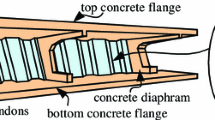Abstract
A number of analytical and numerical approaches exist for modeling concrete structural members. Finite-element analysis (FEA) is a numerical method that is widely applied to concrete structures based on the use of the nonlinear behavior of materials. The challenge of modeling prestressed concrete structures lies in the treatment of the interface between concrete and prestressing tendons. The FEA-modeling technique discussed in this study is based on general-purpose finite-element packages. This study describes FEA of full-scale high-strength self-compacting concrete, HSSCC pre-tensioned T-girders and its comparison with experimental results. Three 9 m length fully pre-tensioned bridge girders, PHSSCC were designed and cast using HSSCC. The girders were instrumented to monitor deflection, pre-tensioned losses, tendon, steel bar, and concrete strains. The girders were then load tested (until failure), predominantly under flexure, and their service and ultimate results including cracking, flexural stiffness, flexural strength, and different ductility indexes were investigated and compared with FEA results. The software package ABAQUS was used to simulate girders and their bonding conditions to verify the accuracy of FEA. A very good agreement was achieved for numerical and experimental crack patterns. The comparison of finite-element modeling (FEM) and experimental results of load-upward and downward deflections indicated satisfactory agreement throughout the load history of the beams until failure. Comparing FEM and experimental results, reasonable agreement was observed for the two methods of ductility indexes. Finite-element modeling tends to overestimate stress in prestressed tendons at the ultimate state of specimens.











Similar content being viewed by others
References
ACI Committee 237, “Self-Consolidating Concrete”, ACI 237R-07, American Concrete Institute, Farmington Hills, 2007
Khayat KH, Feys D, “Design, Production and Placement of Self-Consolidating Concrete”, RILEM Bookseries 1, Montreal, 2010
Padmarajaiah SK, Ramaswamy A (2002) A finite element assessment of flexural strength of prestressed concrete beams with fiber reinforcement. Cement Concr Compos 24:229–241
Ayoub A, Filippou FC (2010) A finite-element model for pre-tensioned prestressed concrete girders. Struct Eng 136(4):401–409
Wehbe N, Stripling C (2013) Experimental assessment of flexural strength and serviceability of prestressed SCC bridge I girders with composite decks. KSCE J Civ Eng 17(3):540–549
Maghsoudi M, Maghsoudi AA, Heshmati AA (2016) The monitored and theoretical ultimate moment and ductility of pre-tensioned HSSCC bridge girders. Struct Concrete 17(5):883–895
Trejo D, Beth HM, Hoon KY (2008) Self-consolidating concrete for precast structural applications, a research project performed in cooperation with the Texas department of transportation and the federal highway administration. Texas Transportation Institute, USA
AASHTO (2006) LRFD Bridge Design Specifications, 6th edn, American Association of State Highway and Transportation Officials, Washington
Khayat KH, Mitchell D (2009) Self-consolidating concrete for precast, prestressed concrete bridge elements”, NCHRP 628 report
Craeye B, Van Itterbeeck P, Desnerck P, Boel V, De Schutter G (2014) Modulus of elasticity and tensile strength of self-compacting concrete: survey of experimental data and structural design codes, 54, pp 53–61
Huang Y, Kang T, Ramseyer C (2010) Background to multi-scale modelling of unbonded post-tensioned concrete structures. Int J Theor Appl Multiscale Mech 1(3):219–235
Abaqs User’s Manual (2014) Volumes I to III, Hibbitt, Karlson & Sorenson, Inc., Pawtucket
Lou T, Kang T, Lopez SMR, Lopez AV (2015) A comparative study of continuous beams prestressed with bonded FRP and steel tendons. Compos Struct 124:100–110
Mercan B, Schultz AE, Stolarski HK (2010) finite element modeling of prestressed concrete spandrel beams. Eng Struct 32:2804–2813
Ibrahim AM, Mubarak HM (2009) Finite element modeling of continuous reinforced concrete beam external prestressed. Eur J Sci Res 30(1):177–188
Lou TJ, Xiang YQ (2006) Finite element modeling of concrete beams prestressed with external tendons. Eng Struct 28:1919–1926
Yapar O, Basu PK, Nordendale N (2015) Accurate finite element modeling of pre-tensioned prestressed concrete beams. Eng Struct 101:163–178
ACI Committee 318 (2011) Building Code Requirements for Structural Concrete and Commentary, ACI 318-11, American Concrete Institute, Farmington Hills
PCI Self-consolidating concrete FAST team (2003) Interim guidelines for the use of self-consolidating concrete in PCI member plants, PCI Committee Summary Report
Lee J, Fenves GL (1998) Plastic-damage model for cyclic loading of concrete structures. Eng Mech 124(8):892–900
CEB-FIP model code (1990) Comite-Euro International du Beton/Federation Internationale de la Precomtrainte, CEB-FIP-90, London
Grassl P (2004) Modelling of Dilation of Concrete and Its Effect in Triaxial Compression”. Journal of Finite Element Analysis Design 40:1021–1033
Huang Y (2012) Finite Element Method for Post-tensioned Prestressed Concrete Structures”, A dissertation Submitted to the Graduate Faculty of Oklahoma in Partial Fulfillment of the Requirements for the Degree of Doctor of philosophy in Civil Engineering, Norman, Oklahoma University, USA
Stavroulaki ME, Leftheris BP, Stavroulakis GE (1997) Optimal prestress in modal analysis via induced temperature modeling. Struct Optim 3(2–3):95–103
Chapra SC, Canale RP (1988) ‘‘Numerical Methods for Engineers”, 2nd edn. McGraw-Hill, New York
Naaman AE, Harajli MH, Wight JK (1986) Analysis of ductility in partially prestressed concrete flexural members. PCI J 31(3):64–87
Naaman AE, Jeong S (1995) Structural ductility of concrete beams prestressed with FRP tendons. In: Taerwe L, Spon EFN. Proceeding of The Second International RILEM Symposium, Ghent, Belgium, 379–386
Acknowledgements
The authors would like to thank Kerman Province State Highway and Transportation officials for their financial support and Arash Ali Heshmati for assisting in the construction of the specimens. Thanks are also due to the faculty of Civil Engineering at the Shahid Bahonar University of Kerman for providing the laboratory test facilities.
Author information
Authors and Affiliations
Corresponding author
Ethics declarations
Conflict of interest
The authors declare that they have no conflict of interest.
Rights and permissions
About this article
Cite this article
Maghsoudi, M., Maghsoudi, A.A. Finite Element and Experimental Investigation on the Flexural Response of Pre-tensioned T-Girders. Int J Civ Eng 17, 541–553 (2019). https://doi.org/10.1007/s40999-018-0290-3
Received:
Revised:
Accepted:
Published:
Issue Date:
DOI: https://doi.org/10.1007/s40999-018-0290-3




